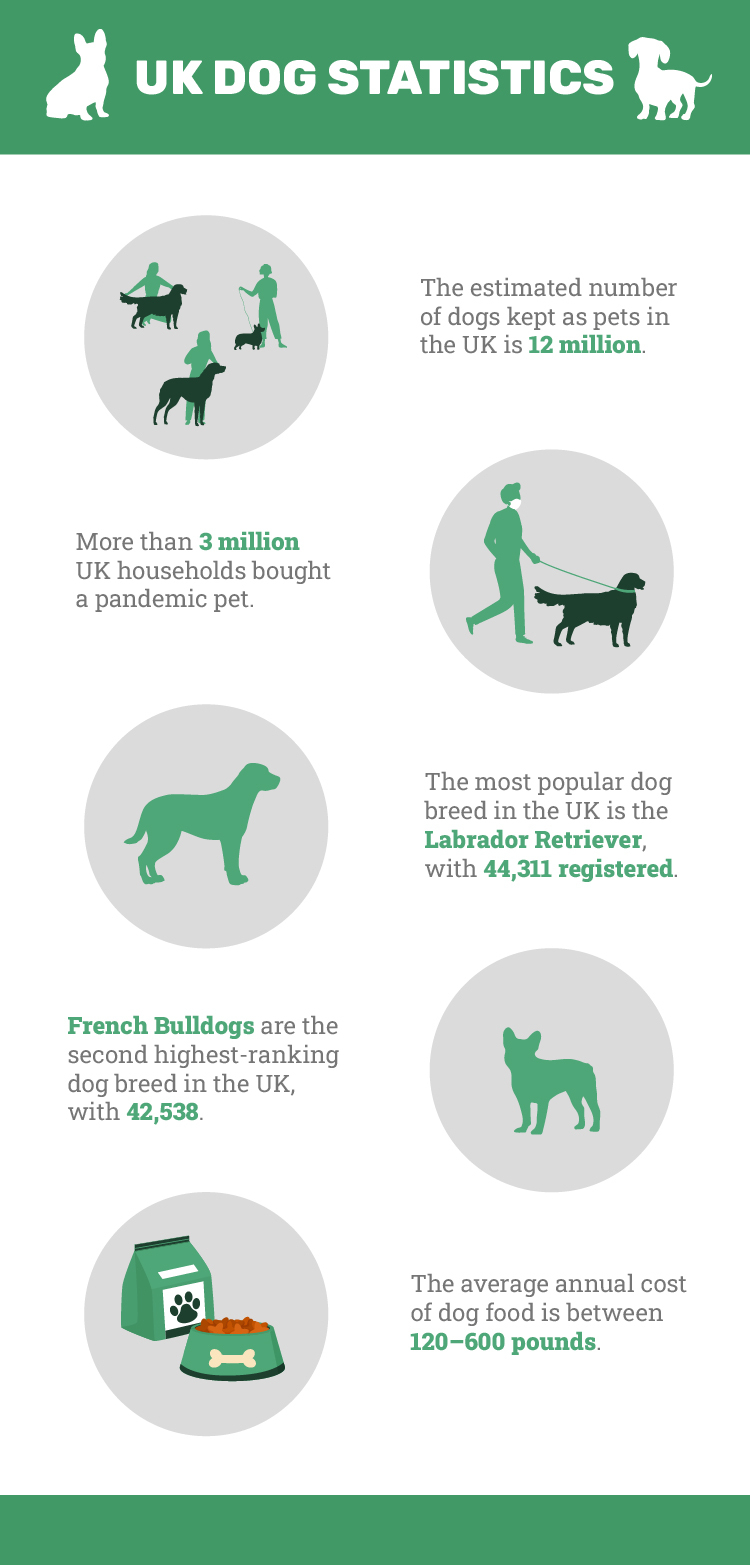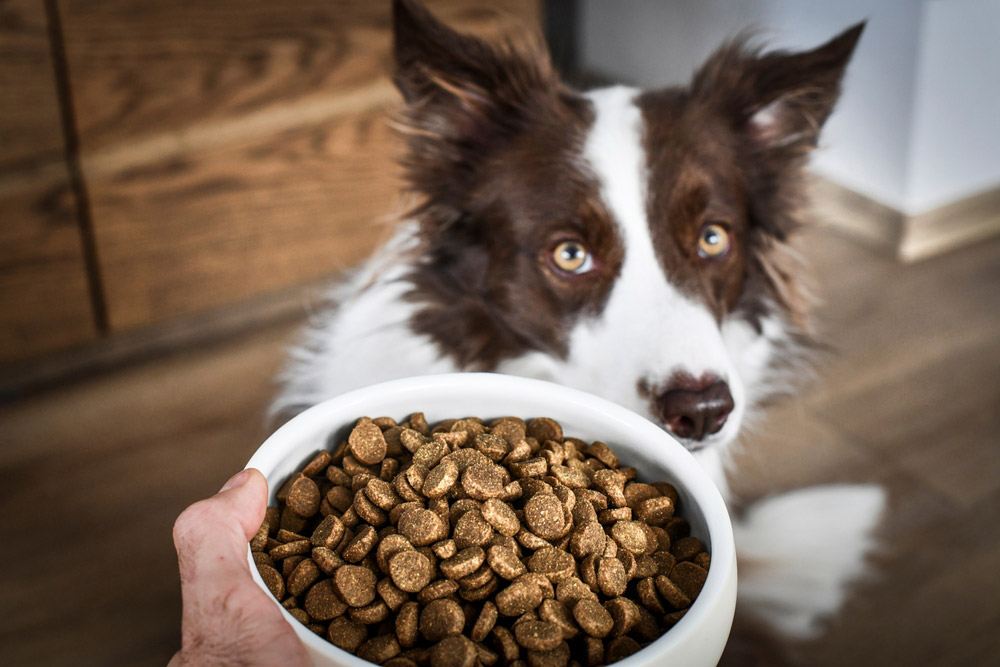Click to Skip Ahead
Note: This article’s statistics come from third-party sources and do not represent the opinions of this website.
Dogs are incredibly popular in the UK. Following Germany, the UK has the second-highest dog population in Europe, and owners spend billions of pounds on pet products and services each year. You can learn more about UK dog statistics, including how many households have dogs, the average number of dogs owned, the breeds that are the most popular in the UK, and how many dogs are trained with a trainer or at home.
Top 10 UK Dog Statistics
- The estimated number of dogs kept as pets in the UK is 12 million.
- More than 3 million UK households bought a pandemic pet.
- 59% of people in England own a dog compared to 68% of people in Wales.
- Of all the pet owners in the United Kingdom, 31% of people own at least one dog.
- Only 20% of people in the UK got their pet dog from a rescue or shelter.
- The most popular dog breed in the UK is the Labrador Retriever, with 44,311 registered.
- French Bulldogs are the second highest-ranking dog breed in the UK, with 42,538.
- Owning a dog can cost close to 19,000 pounds.
- The average annual cost of dog food is between 120-600 pounds.
- 29% of UK dog owners would skip a meal so their dog could eat.

Number of Dogs as Pets in the UK
1. The estimated number of dogs kept as pets in the UK is 12 million.
(Statista 1)
In 2023, it was reported that 12 million dogs were being kept as pets by people in the United Kingdom. There is no doubt that people in the UK love dogs! However, the number of pet dogs actually decreased by almost a million compared to last year. Owning a dog can be expensive and a lifetime commitment, which may be why some people opt out of getting a pet dog.

2. More than 3 million UK households bought a pandemic pet.
(UK Pet Food)
It is no surprise that the pandemic caused a surge in pet adoption in many countries. More than 3 million households in the United Kingdom welcomed a dog into their homes. The pandemic was a cause of stress for all countries, and while people were on lockdown, getting a pet helped improve their lives.
3. 59% of people in England own at least one dog compared to 68% of people in Wales.
(TGM Research 1 and 2)
Dogs are the most popular pets of choice by people in the UK. Almost 60% of pet owners in England own at least one dog, while close to 70% of Welsh people have a dog (or two!).

4. Of all the pet owners in the United Kingdom, 31% of people own at least one dog.
(Statista 3, NCBI)
In the United Kingdom as a whole, 31% of pet owners have at least one dog—almost a third of the country! The households will vary by number: a family of four could have one dog, while a married couple could have four. Regardless of how the dogs are distributed, they are loved by their owners.
5. Only 20% of people in the UK got their pet dog from a rescue or shelter.
(Statista 2)
In the UK, the most common way to get a dog is through a breeder, with 33% of people choosing this method. The second most common place to get a dog is through a private seller. A private seller differs from a breeder in that a breeder is licensed, whereas a private seller does not do this for profit. Only 20% of people get dogs from shelters or rehoming centres. The other 22% of people get their dog in other ways, perhaps being gifted one by a friend or relative.
Most Popular Dog Breeds in the UK
6. The most popular dog breed in the UK is the Labrador Retriever, with 44,311 registered.
(Statista 4)
The Labrador Retriever had long been the most popular dog breed in the United States, only to have the top place snagged by the French Bulldog. However, the Labrador Retriever has won the hearts of UK residents and is ranked as the most popular dog breed based on registration. Over 44,000 of these beloved dogs are part of people’s lives.

7. French Bulldogs are the second highest-ranking dog breed in the UK, with 42,538.
(Statista 4)
Watch out, Labrador Retrievers! You saw what happened in the USA; the French Bulldog came for your top placement and won! Registered French Bulldogs are at 42,538, less than 2,000 behind Labrador Retrievers. What will happen in 2024? We will have to wait to find out.
Costs of Dog Ownership in the UK
8. Owning a dog can cost close to £19,000.
(Experian PLC)
Owning a dog is not cheap, but some people do not know how much it actually costs. On average, it costs the owners about £1,500 a year to take care of a dog. This includes food, vet bills, and other essentials needed to keep the dog healthy and happy. This annual cost will vary by the breed, as larger breeds will need much more food than smaller breeds. But smaller breeds live longer than larger breeds. It is essential to know what you are getting into when considering getting a dog.

9. The average annual cost of dog food is between £120–600.
(Battersea.org.uk)
One of the most significant costs of dog ownership is food. Depending on the size of the dog and if they have specific dietary needs, feeding them could cost up to £600. However, if you have a smaller breed dog and can find a decent quality discount, you may spend only £120 annually.
10. 29% of UK dog owners would skip a meal so their dog could eat.
(Vetstoria, Experian PLC)
Most people consider their dogs family, so if the monthly budget is stretched, almost 30% of people will skip a meal to use that money to buy their furry pal some food. While this sounds noble, by July 2023, almost 12,000 reports of abandoned animals were made to the RSPCA. More and more people are either surrendering or abandoning dogs, most likely due to costs.

 Frequently Asked Questions About UK Dog Statistics
Frequently Asked Questions About UK Dog Statistics
Why has pet ownership gone down?
Pet ownership has decreased in the UK primarily due to the cost of keeping them. Dogs can be quite expensive, and with the changes in the economy, many people realize they cannot afford a dog anymore. The RSPCA reported that they have seen an 11% increase in dogs being surrendered by their owners because they can no longer afford to have them. It is a sad reality that some dogs who get purchased or adopted get returned due to costs. (Experian PLC)

What is the second most popular pet in the UK?
Cats are the most popular pets in the UK. There are about 11 million pet cats in the UK, which is not too far off from the number of dogs!
Coming in third place are rabbits, with a pet population of 1.5 million. Fourth place belongs to indoor birds, such as budgies or parakeets, with 1.3 million. (Statista 5)
How Well Are UK Dogs Trained?
According to research, almost every dog owner believes their dog is trained better than others. 46.2% of people rated other people’s dogs at a 4 or 5 on a scale of 10, while 51.9% gave their own dog a 7 or 8 out of 10 for training. Furthermore, people who don’t own a dog gave dogs a higher score than those with dogs. (Pet365)

How Is Dog Training Beneficial?
Behavioral problems are among the most common reasons for surrendering a dog to a shelter. Dog training services and classes can mitigate or prevent behavioral problems, but some owners don’t have access to these services due to costs. In addition to the costs of the dog training services, owners in low socioeconomic classes may hit other barriers to attending dog training classes, such as transportation or work schedules.
According to a study, owners were given face-to-face and online classes to determine dropout rates. The online classes had higher attendance, and the face-to-face classes had lower dropout rates among higher-income owners. The face-to-face training classes also had better attendance from owners in the area. These results suggest that the limitations of dog training for individuals in low socioeconomic classes are more than financial. This research hopes to identify opportunities to provide people with low socioeconomic backgrounds with access to dog training classes. (National Center for Biotechnology Information)
Final Thoughts
Dogs are beloved pets in many countries, including the United Kingdom. While the pet dog population declined, dogs are still the favored pets of almost a third of British people. Unfortunately, thousands of pets—dogs included in this number—were abandoned in 2023. Owning an animal is a commitment people need to take seriously. However, that commitment is still well understood amongst most dog owners in the United Kingdom.













